Short Book Reviews
Hanna Kryszewska, Poland
Hanna Kryszewska is a teacher, teacher trainer, trainer of trainers. She is a senior lecturer at the University of Gdańsk, and EU Teacher Training College where she trains pre-service teachers. She is co-author of resource books: Learner Based Teaching, OUP, Towards Teaching, Heinemann, The Standby Book, CUP, Language Activities for Teenagers, CUP, The Company Words Keep, DELTA, and a course book series for secondary schools: ForMat, Macmillan. She is also co-author of a video based teacher training course: Observing English Lessons. Hania is a Pilgrims trainer and editor of HLT Magazine. E-mail: hania.kryszewska@pilgrims.co.uk
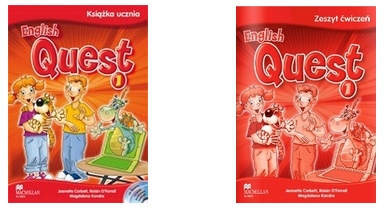
Macmillan English Quest 1. Pupil’s Book and Activity Book. J. Corbett, R. O’Farrell, Macmillan. (2011) ISBN 978-0-230-44380-8, pp.88,. This course book is part one of a new two level English course which is aimed at children at early primary level. It has been published for the international market and also adapted for local markets, such as Poland, a market I am very familiar with. The course has been specifically written for learners who cannot read and write in year one and slowly learn these literacy skill in year two. In this way the authors implement the principle of a text free period, which is the best option if in class there are children who are six or seven years old, i.e. there is varying degree of literacy. In the pupil’s book there are some elements of reading ( match the word with the picture) or writing ( tracing). The activities in the pupils book can be treated selectively; some for the younger ones and some for the older ones. Such mixed classes are common in Poland so no wonder there is an adaptation of the course for the Polish market. ( There may be others I am not aware of). What worries me is: if the early primary school involves three years, what kind of book will the teacher be recommended for year three to provide continuity? The in-house characters in the book are children who experience fantastic adventures thanks to an amazing computer game. They go to different places, learn about people and cultures. Some educational bodies and parents may not like the glorification of a computer game which controls the children’s experiences or the fact the children meet a lot of dragons, dwarfs and talking animals. Also a lot of the illustrations are reminiscent of cheap seventies and early eighties cartoons unfortunately loved by some publishing houses.
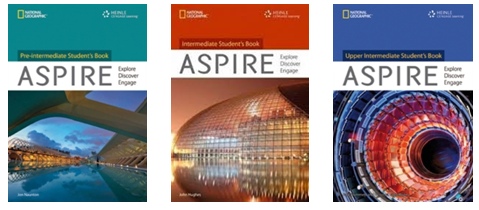
Aspire – Pre-intermediate Student’s Book. J. Naunton and R. Crossley (2013) National Geographic Learning. CENGAGE Learning. ISBN 978-1-11-77068-6, pp 160. This book is one of the six course books in a series aimed at the upper secondary learner. Like many CENGAGE courses these days it has a lot of National Geographic content: articles, photography and videos. Thanks to this the learners not only learn English but also learn about the world and remarkable people, such as: Columbus, Kit DesLauriers, the climber, or Jeff P’Leray, the tornado hunter. In each unit there is a good balance of the four language skills, vocabulary and grammar work. The sections I like the best are those devoted to everyday English the way it is used in the real world by native speakers or as lingua franca, and Case Study sections which encourage the students to learn and research the language outside or beyond the classroom. The course is challenging for the learners, both intellectually and linguistically.
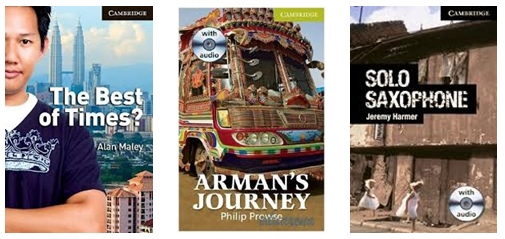
Cambridge English Readers. (full details at www.cambridge.org/elt/readers). Books in this impressive series of graded readers have won many prizes in the Language Learner Literature Award, which is not surprising. They have been written specifically with the language learner in mind and are not simplified versions of well known books or classics. The stories are original and there is no way the learners may have seen a film based on the book or have read it in their mother tongue. This is the beauty of this series as all the stories are fresh and new. Also if a great novel or play is simplified to, say, A2 level it loses so much of its appeal and value that the reader may rightly wonder why the author or the novel are so famous, and may also rightly doubt what they are told about the value of the particular piece. The readers come at seven levels: from starter to advanced, and address a wide range of contemporary topics and themes, and were written by well known ELT authors and personalities, e.g. Alan Maley. Philip Prowse, Jeremy Harmer, Sue Leather just to name a few. The readers come with an audio recording and you can listen to samples of the recordings at:
http://www.cambridge.org/gb/elt/
On the site you can also find additional worksheets and placement tests helping the learners choose the right book. A really innovative and interesting series which will motivate your learners and help them improve their extensive reading and/or listening skills.
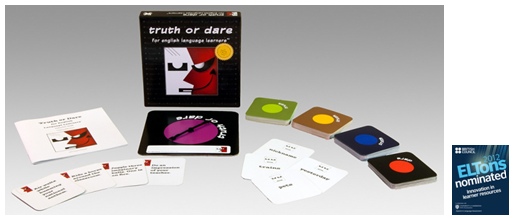
Truth or Dare for English Language learners. Created by Brian Grover. (2010) Speekeezy Publications. ISBN 9688-1819-8, 1 game box, 200 card, spinner, mini whiteboard, instruction guide. This game is an adaptation of a well known traditional game for ELT purposes. The topics for the ‘truth’ cards have been selected in such a way that a great variety is represented, e.g. mistake, being late, crime. In some cultures, countries or working with less mature learners the teachers may have to remove some of the topic cards from the pack, because they decide some are less appropriate e.g. first love, worst/best date, insurance. The author suggests that before one of the participants in the game starts to talk on the subject, all the group brainstorm useful vocabulary around the topic. In this way a more collaborative approach is fostered, unlike in the traditional version of the game. When the learners want to escape the topic and opt for the ‘dare’ card, the things to do are fun e.g. make a shadow puppet against the wall, act a famous cartoon character. Like with the ‘truth’ cards, the ‘dare’ cards need to be weeded before you use them in class, e.g. make 10 loud burps may be culturally inappropriate, flip a coin until you get three heads in a row may take too long or learners may be unable to draw the Mona Lisa on the board as the painting is not a recognisable icon in their culture or part of the world. But these obstacles can be easily overcome. Overall the game is fun, useful in class as preparation for a speaking test or as a fun lesson. The author suggests some variations for the game and states which of the three sets of the ‘truth’ cards is more suitable for what level.
From the author: there's a downloadable press kit on my support site with images and a bit of a backgrounder on the pedagogy behind the game. Visit the Speekeezy website www.speekeezy.ca and click the link titled "Downloads" to find the Press Kit.
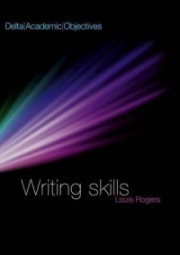
Writing skills. L. Rogers. DELTA Publishing. (2011) ISBN 978-1-905085-58-3, pp.120. This book has appeared in the Delta Academic Objectives series the aim of which is to prepare students for studying in English. The author has extensive experience in teaching academic English, which is reflected in the book. In the book it academic writing involves genre specific language focus, structuring and organising, thinking critically, using texts, reviewing and evaluating texts. All these areas are covered in the book. The topics are quite general like education, leadership, language learning sustainability, crime etc. so they are more suitable for prep courses and possibly undergraduate courses than post-graduate, regardless of what the blurb states. Post-graduate students will need more complex and area specific lexis for their writing skills. At the end of the book there are 10 sets of the most frequent words of the Academic Word List in the Academic Corpus. At first sight it looks like a great idea but what the learners really need is whole chunks containing these high frequency words to be able to use the words successfully. I am sure that in the hands of an experiences teacher these lists can be become very useful.
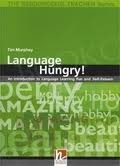
Language Hungry! T. Murphey. (2006) Helbling Languages. ISBN 978-3-902504-78-4, pp 166. This book has appeared in the well established Resourceful Teacher Series but it is very different from the other titles. It is not ‘symmetrical’, following the pattern of books in the series nor jam packed with activities although there are some. Instead it is jam packed with ideas, observations and small tips about how to learn more successfully. Probably not surprisingly, one of the first areas the book addresses are the reasons why learning seems unsuccessful or follows the route of a roller coaster, as the author puts it. (NB. They are: lack of understanding, negative emotions, fatigue, information overload and not enough time for recycling, and competition for attention.) The reasons are briefly described and then a few tips follow. The other areas the book addresses include: why is it better to talk to non native speakers and how you can organize extra practice, becoming aware of reactions to mistakes, how to put a foreign language into your head, how to use songs to help language learning, the best ways of remembering, and how to enjoy learning more. Overall the book touches upon topics which are very humanistic so the book, in fact, implements humanising language teaching. I believe the book is an inspiring read for teachers who will select suitable areas and share them with their students. The book is witty, clever, engaging and dotted with well chosen quotes. Highly recommended.
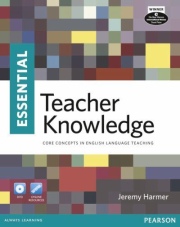
Essential Teacher Knowledge. J. Harmer. (2012) Pearson. ISBN 978-1-4082-6804-9, pp 286. This book comes from Jeremy Harmer whose methodology books have been a must on various types of teacher training courses for decades. The new book is a foundation level manual for future teachers of general English and those who are already practising teachers of other subjects who retrain to become English or CLIL teachers. The blurb also says that the book is suitable for future teachers of young learners, and indeed out of the 109 units in the book 11 are devoted to teaching YL. However, I find that teachers of YL need much more foundation in many more areas and at least a few DVD extracts showing a YL class. And conversely, quite a few of the units in the book are irrelevant to teachers of YL or are too detailed. However, I find that the book would be also ideal on CELTA courses, especially for native speakers of English training to become teachers of English. This is because the manual has a unique formula as each unit is a combination of pedagogical grammar with methodology issues. ( NB. Native speakers who want to become teachers of English often have problems in understanding or explaining grammar and language issues of their mother tongue). Usually each unit starts with a small text illustrating subjects such as the use of the four various types of phrasal verbs, some language analysis and theory, followed by teaching ideas. The book is accompanied by a DVD and many of the points and key teaching techniques are demonstrated by extracts showing real classroom situations. The book is easy to navigate through as there are little arrows pointing to a page relating to the issues discussed in a given unit. In this way little pathways are created, which offer an alternative to the linear sequence of the book. There is extra on-line material on the web with audio material for the sections on pronunciation, downloadable activities, more videos, etc. The book has an international or global airs thanks to stories, texts and photographs from classrooms from all over the world. Sometimes there are minor slips like the Polish name Katarzyna is misspelt as Katazyna (p 62). But then nobody’s perfect. Overall I am sure teacher trainers all over the world will welcome this publication as well as teachers preparing for the TKT test. In this case they could even use the manual for self-study.

Please check the Methodology and Language for Primary Teachers course at Pilgrims website.
Please check the Methodology and Language for Secondary Teachers course at Pilgrims website.
Please check the Teaching Advanced Students course at Pilgrims website.
Please check the Teaching Academic English course at Pilgrims website.
Please check the Creative Methodology for the Classroom course at Pilgrims website.
Please check the How to be a Teacher Trainer course at Pilgrims website.


|